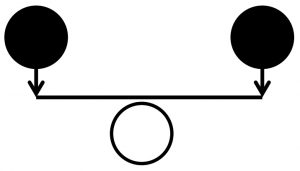Equilibrium & Lack Thereof (Upd: Jun 10, ’22)
“The second paradox [of acting] […] [is] that an actor must be in control and out of control at the same time.” – Stephen Wangh7
Cultivating body balance or equilibrium with the ability to also turn it off is essential for a ready-for-anything approach to butoh.

According to Contemporary Metaphor Theory, BALANCE is an image schema that
provides an understanding of physical or metaphorical counteracting forces based on a prototypical schema consisting of countervailing forces acting on a target that is a: “(1) point; (2) line; (3) plane and is based in bodily experience, such as maintaining (1) erect posture; (2) normal bodily states such as temperature; (3) may be applied metaphorically to provide an understanding of other experiences, such as balance of the visual field with respect to art.”¹
Image schemas to Lakoff and Johnson are “recurrent patterns in perceptual-motor experience that derive from our bodily interaction with the physical world.”² Like so many other image schemas, we are bombarded with this balance schema at all moments of our lives.
Losing your balance (which is always excellent to resonate with) is a form of DIVERSION image schema, which involves forces that physically or metaphorically meet and produce a change of direction.”³ We must learn how to live with not being in balance, especially since a primary metaphor is BEING IN CONTROL IS BEING IN PHYSICAL BALANCE.4 Can we de/reconstruct this?
Exercise 1: One Leg Blindfold
With closed eyes or with a blindfold, balance on one leg (or do the yoga tree pose) for as long as you can. Also try single leg shuffling. Spin once or twice then stand on one leg. Dance the single leg. Then dance the whole body while on the single leg.
Exercise 2: Cup of Water
Ash walk while holding a cup of water. Make sure the water has the most minimal movement.
Exercise 3: Tea Bag
Ash walk while holding the end of a tea bag. Make sure the tea bag does not swing as best as you can.
Exercise 4: Rock on Head
Ash walk while balancing a rock on your head.
Exercise 5: Kea Tonetti’s Multiple Rock Balancing Walk
This exercise is for outside in nature and was shown in one of Özerk Sonat Pamir’s classes.* One participant has arms out in front (whether bent or not; not bent is obviously more tiring). Another participant will put as many tiny rocks on any surface of the person one an find. The person with all the rocks will be walking slowly trying to make sure no rocks fall. At the same time, the rocks keep bering placed on the body of the walker.
Two Approaches to Center
“Butoh plies the excitement of being off-balance, and the psychic path of shaking and plodding.” – Sondra Fraleigh and Tamah Nakamura6
Stephen Wangh, a Grotowski instructor, defines two approaches to being centered. The first is the circle of concentration which excludes disturbing influences from outside (expending energy). He gives the image of holding a stick tight at the base so that it stays in one place5
The second is a constantly redefining center, which allows for outside influence completely (absorbing energy), which is like balancing the stick at the palm of your hand and readjusting your hand (the same physics occurs with the segway and video stabilization). Wangh adds: “Distraction is treated not as a problem that needs to be overcome but as a source of creative energy.”5
Exercise 1: Dizzy Resonance A (Circle of Concentration Exercise)
Turn in place as fast as you can for some time. Then stop. Do not lose your balance. Do not be effected by your vision nor the equilibrium properties of the inner ear. Enter into a walk. Knife through it out pure will power. Mind over matter.
Exercise 2: Stick (Constantly Redefining Center Exercise)
Hold a 30 cm stick or ruler on the palm of your hand. Focus on the top. The objective is to keep the stick as straight as possible with very limited movement. If there is movement, your body compensates. Resonate with your body movements.
Exercise 3: Drunk (Constantly Redefing Center Exercise)
Enter into the drunk qualia where your center is constantly shifting because you are constantly losing your balance. Resonate with shifting centers.
Exercise 4: Dizzy Resonance B (Constantly Redefining Center Exercise) (Intermediate)
Refer to exercise 2 before engaging in this exercise. Turn in place as fast as you can for some time. Then let yourself go and ride the waves of dizziness. This is full resonance with the dizzy state. You redefine your body position from your state of dizziness.
Exercise 5: Circle of Concentration to Redefining Center Synthesizer Knob (Intermediate)
Above exercises must be known for this one. Using the metaphor of the synthesizer knob, gravitate from an emphasis on circle of concentration over to an emphasis on redefining center. This can be done either with a stick or with your entire body out of a state of dizziness. In the case of dizziness, transition between making one linear pathway to being thrown about.